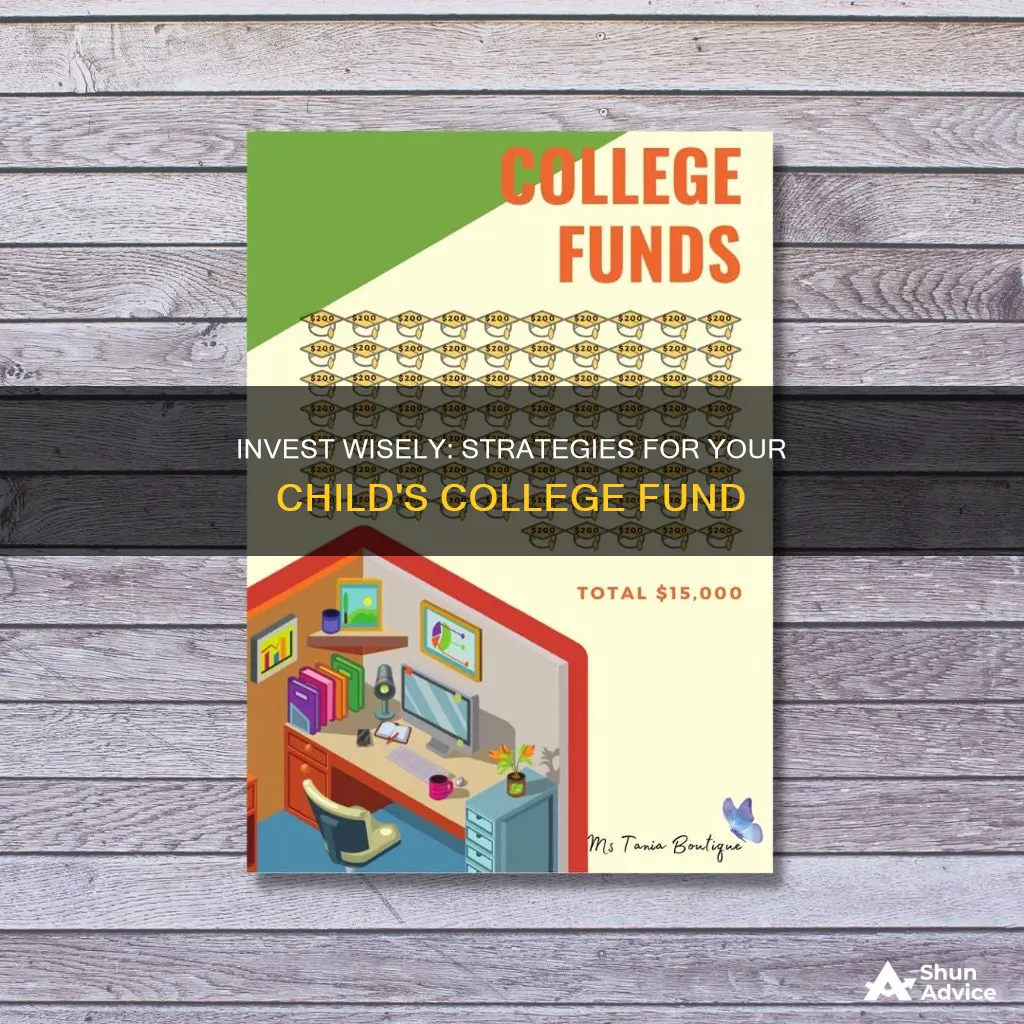
Investing in a college fund is a great way to help your child transition into adulthood. With the average tuition fees for the 2022-2023 school year ranging from $39,723 for private colleges to $10,423 for public, in-state colleges, it's no surprise that many parents want to help their children avoid accruing debt. There are several fund types to choose from, including 529 plans, Coverdell Education Savings Accounts, UGMA accounts, and IRA accounts. Each has its own rules and tax consequences, so it's important to do your research and choose the best option for your needs. The key to saving for college is to start early and save often, so you don't have to borrow as much.
| Characteristics | Values |
|---|---|
| When to start saving | As early as possible, ideally when the child is born |
| How much to save | Aim for about one-third of future college costs |
| How often to save | Monthly or yearly |
| How much to contribute | Modest amounts like $25-$100 from each paycheck |
| Who can contribute | Family members can contribute by opening their own 529 plan accounts or by making contributions to an established 529 account |
| Types of accounts | 529 plans, Coverdell Education Savings Accounts, UGMA accounts, IRA accounts, mutual funds, custodial accounts, savings bonds, home equity loans, prepaid tuition plans |
| Tax advantages | Earnings grow tax-deferred, tax-free withdrawals for qualified education expenses, no annual account fees, tax incentives for contributions by state residents |
| Financial aid eligibility | 529 plans have a small effect on federal financial aid eligibility, Coverdell accounts and UGMA accounts reduce aid eligibility |
What You'll Learn

529 plans
There are two main types of 529 plans: education savings plans and prepaid tuition plans. The former is more common, with account holders contributing money that is invested in a preset selection of investment options, usually mutual funds. Prepaid tuition plans, meanwhile, allow account owners to lock in current tuition rates for future attendance at selected colleges and universities.
There are no income restrictions on 529 plans, and they offer both federal and state tax benefits when used for qualified education expenses. Earnings and withdrawals are completely tax-free when used for college, and there may be additional state tax benefits. For example, withdrawals spent on qualified higher education expenses and up to $10,000 per beneficiary per year in K-12 tuition avoid federal income and capital gains tax.
The rules and fees of 529 plans differ from state to state, and you need to invest in your home state's plan if you want a state tax deduction or credit. However, some states will allow you to invest in their plans as a non-resident if you forgo a tax break.
There are no annual contribution limits for 529 plans, but many states cap the total amount that can be contributed over time, ranging from $235,000 to $575,000. Contributions of up to $90,000 per beneficiary in a single year are not subject to the federal gift tax.
While 529 plans are a great way to save for college, it's important to note that withdrawals are only tax-free if they are used for qualified education expenses. If the money is used for anything else, it may be subject to taxes and a 10% penalty.
Who Should Invest in Mutual Funds?
You may want to see also

Coverdell Education Savings Accounts
A Coverdell Education Savings Account (ESA) is a trust or custodial account set up in the United States to pay for qualified education expenses for the designated beneficiary of the account. The account can be used for both higher education and qualified elementary and secondary education expenses.
To set up a Coverdell ESA, the designated beneficiary must be under the age of 18 or be a special needs beneficiary. The account must be designated as a Coverdell ESA when it is created, and the document creating and governing the account must be in writing. Contributions must be made in cash and are limited to $2,000 per beneficiary per year, combined from all sources. The beneficiary can receive tax-free distributions to pay for qualified education expenses. However, if a distribution exceeds the beneficiary's qualified education expenses, a portion of the earnings is taxable to the beneficiary.
Coverdell ESAs offer tax-free investment growth and tax-free withdrawals when the funds are spent on qualified education expenses. In addition to college expenses, certain K-12 purchases are also considered qualified expenses, including books, supplies, equipment, academic tutoring, and special needs services.
Coverdell ESAs have lower maximum contribution limits per child and are only available to families below a specified income level. For the 2024 tax year, the income limit is $190,000 for married taxpayers and $95,000 for single taxpayers to qualify for the full $2,000 contribution. The contribution limit is lower for higher earners and is phased out for single taxpayers with an AGI of $110,000 or more and joint filers with an AGI of $220,000 or more.
Coverdell ESAs are similar to 529 plans but have some key differences. While both accounts offer tax-free withdrawals for qualified education expenses, Coverdell ESAs have lower contribution limits and are restricted to families below a certain income level. Additionally, Coverdell ESAs can be used for a wider range of expenses for elementary and secondary school, while 529 plans are typically limited to tuition for K-12 schools.
Low-Cost Trading Funds: Smart Investment, Smart Returns
You may want to see also

Custodial accounts
One of the key advantages of custodial accounts is the flexibility they offer in terms of spending. The money saved in these accounts can be spent on anything, as long as it is for the benefit of the minor. This means that it can be used not just for college tuition but also for other expenses such as cars and airline tickets. Additionally, the value of the account is removed from the donor's gross estate, which can have favourable tax implications.
However, it is important to note that earnings and gains from custodial accounts are taxed to the minor and subject to the "kiddie tax". This means that unearned income over a certain threshold (which was $2,500 in 2023) for children up to the age of 23 is taxed at the parent's rate. Another consideration is that once the child reaches the legal age, they gain full rights to the account and can use the money at their discretion, which may differ from the parent's original intention of saving for college.
Best Banks for Investment: Where to Invest Your Money?
You may want to see also

US savings bonds
Series EE and Series I savings bonds, available from the US Treasury Department, are a good option for parents looking to save for their children's college education. These bonds can be purchased digitally from the Treasury at TreasuryDirect.gov. They are no longer issued in paper form. To qualify for tax benefits, the bonds must be registered in the name of the parent or the parent and their spouse, and not the child. The owner of the bond must be 24 years or older when the bond is issued.
The interest earned on these bonds can be used tax-free if the funds are used for qualified educational expenses for the parent or dependent child. However, books and room and board are not considered qualified expenses. The expenses must occur in the same tax year in which the bonds are redeemed. Additionally, the qualified education expenses must not already be covered by financial aid, scholarships, 529 accounts, or other tax breaks.
The maximum investment allowed is $10,000 per year, per owner, per type of bond. For married couples filing jointly, the maximum investment is $20,000 per year. There are also income limits to qualify for the full tax exclusion. For the 2016 tax year, a married couple filing jointly could take the full tax exclusion if their income was below $116,300 and a partial exclusion if their income was between $116,300 and $146,300. Single filers could take the full exclusion if their income was below $77,500 and a partial exclusion for incomes between $77,500 and $92,550.
Savings bonds can also be transferred to a 529 account or Coverdell Education Savings Account (ESA) with no penalty. This allows for a broader set of qualified higher education expenses, as savings bonds are limited to tuition and fees, while 529 plans can be used for textbooks, supplies, room and board, computer equipment, and more. Additionally, 529 plans do not have income phase-outs, which savings bonds have.
Savings Strategy: Mutual Funds Investment Allocation
You may want to see also

Roth IRA
A Roth IRA is a personal finance tool used for retirement that offers tax advantages. However, it can also be used to save for your child's college fund. While it isn't a great college savings tool in isolation, it can be used in conjunction with a 529 plan. Here are some of the pros and cons of using a Roth IRA for a college fund:
Pros
- Any unspent funds can still be used for retirement. If your child decides not to go to college, gets scholarships, or doesn't need all the funds in the Roth IRA for education expenses, the account can be kept as a retirement savings vehicle.
- Your Roth IRA balance has no effect on financial aid. Money in a Roth IRA isn't counted when calculating your student aid index (SAI), which determines how much financial aid your student receives. However, you'll have to report withdrawals from the account as income on the Free Application for Federal Student Aid (FAFSA), so it can impact your SAI two years after you start withdrawing funds.
- You have a wider selection of investments. Roth IRAs typically offer more investment options than other education savings vehicles.
Cons
- Your annual contributions have a low cap. With annual contribution limits for Roth IRAs at a maximum of $7,500 (or $6,500 if you're younger than 50), you may not be able to save enough to cover the total cost of your child's education.
- The distributions will be partially taxable. While you can avoid paying an early withdrawal penalty on any distributions used to cover qualified education expenses, you typically have to pay regular income tax on the earnings portion of your withdrawals.
- Using a Roth IRA could mean less money for retirement.
- Your financial aid package could take a hit. When you take money out of a Roth IRA to pay for college, it will be considered income for that year and weigh against you much more heavily the following year.
Invest Wisely: Fidelity New Millennium Fund Offers Diverse Opportunities
You may want to see also
Frequently asked questions
529 plans are a popular option for saving for college. They offer tax benefits, including tax-free withdrawals for qualified education expenses. You can save for future education costs by investing in the market while taking advantage of tax benefits.
A 529 plan is a type of education savings account that offers federal and state tax benefits when used for qualified education expenses. Earnings and withdrawals are tax-free when used for college. The plan is named after the IRS code section that allows adults to save for college in a child's name.
The amount you should save depends on various factors, such as the type of college, degree, and whether the student plans to work while studying. With a 529 plan, you can save and grow your fund without worrying about limits.
The amount saved by parents varies based on their income and how early they start saving. Starting early and saving regularly helps parents set aside more money to reach their goals.







